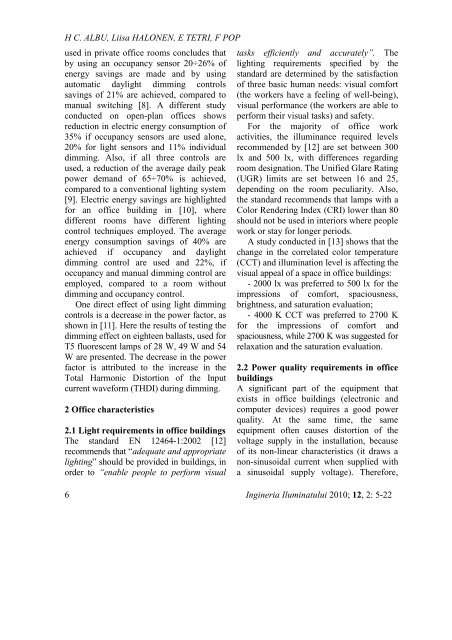ingineria iluminatului - Journal of Lighting Engineering - Prof. Florin ...
ingineria iluminatului - Journal of Lighting Engineering - Prof. Florin ...
ingineria iluminatului - Journal of Lighting Engineering - Prof. Florin ...
Create successful ePaper yourself
Turn your PDF publications into a flip-book with our unique Google optimized e-Paper software.
H C. ALBU, Liisa HALONEN, E TETRI, F POP<br />
used in private <strong>of</strong>fice rooms concludes that<br />
by using an occupancy sensor 20÷26% <strong>of</strong><br />
energy savings are made and by using<br />
automatic daylight dimming controls<br />
savings <strong>of</strong> 21% are achieved, compared to<br />
manual switching [8]. A different study<br />
conducted on open-plan <strong>of</strong>fices shows<br />
reduction in electric energy consumption <strong>of</strong><br />
35% if occupancy sensors are used alone,<br />
20% for light sensors and 11% individual<br />
dimming. Also, if all three controls are<br />
used, a reduction <strong>of</strong> the average daily peak<br />
power demand <strong>of</strong> 65÷70% is achieved,<br />
compared to a conventional lighting system<br />
[9]. Electric energy savings are highlighted<br />
for an <strong>of</strong>fice building in [10], where<br />
different rooms have different lighting<br />
control techniques employed. The average<br />
energy consumption savings <strong>of</strong> 40% are<br />
achieved if occupancy and daylight<br />
dimming control are used and 22%, if<br />
occupancy and manual dimming control are<br />
employed, compared to a room without<br />
dimming and occupancy control.<br />
One direct effect <strong>of</strong> using light dimming<br />
controls is a decrease in the power factor, as<br />
shown in [11]. Here the results <strong>of</strong> testing the<br />
dimming effect on eighteen ballasts, used for<br />
T5 fluorescent lamps <strong>of</strong> 28 W, 49 W and 54<br />
W are presented. The decrease in the power<br />
factor is attributed to the increase in the<br />
Total Harmonic Distortion <strong>of</strong> the Input<br />
current waveform (THDI) during dimming.<br />
2 Office characteristics<br />
2.1 Light requirements in <strong>of</strong>fice buildings<br />
The standard EN 12464-1:2002 [12]<br />
recommends that “adequate and appropriate<br />
lighting” should be provided in buildings, in<br />
order to “enable people to perform visual<br />
tasks efficiently and accurately”. The<br />
lighting requirements specified by the<br />
standard are determined by the satisfaction<br />
<strong>of</strong> three basic human needs: visual comfort<br />
(the workers have a feeling <strong>of</strong> well-being),<br />
visual performance (the workers are able to<br />
perform their visual tasks) and safety.<br />
For the majority <strong>of</strong> <strong>of</strong>fice work<br />
activities, the illuminance required levels<br />
recommended by [12] are set between 300<br />
lx and 500 lx, with differences regarding<br />
room designation. The Unified Glare Rating<br />
(UGR) limits are set between 16 and 25,<br />
depending on the room peculiarity. Also,<br />
the standard recommends that lamps with a<br />
Color Rendering Index (CRI) lower than 80<br />
should not be used in interiors where people<br />
work or stay for longer periods.<br />
A study conducted in [13] shows that the<br />
change in the correlated color temperature<br />
(CCT) and illumination level is affecting the<br />
visual appeal <strong>of</strong> a space in <strong>of</strong>fice buildings:<br />
- 2000 lx was preferred to 500 lx for the<br />
impressions <strong>of</strong> comfort, spaciousness,<br />
brightness, and saturation evaluation;<br />
- 4000 K CCT was preferred to 2700 K<br />
for the impressions <strong>of</strong> comfort and<br />
spaciousness, while 2700 K was suggested for<br />
relaxation and the saturation evaluation.<br />
2.2 Power quality requirements in <strong>of</strong>fice<br />
buildings<br />
A significant part <strong>of</strong> the equipment that<br />
exists in <strong>of</strong>fice buildings (electronic and<br />
computer devices) requires a good power<br />
quality. At the same time, the same<br />
equipment <strong>of</strong>ten causes distortion <strong>of</strong> the<br />
voltage supply in the installation, because<br />
<strong>of</strong> its non-linear characteristics (it draws a<br />
non-sinusoidal current when supplied with<br />
a sinusoidal supply voltage). Therefore,<br />
6 Ingineria Iluminatului 2010; 12, 2: 5-22
















